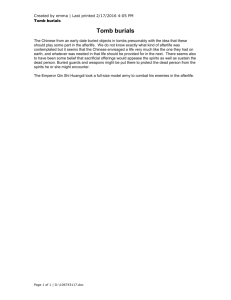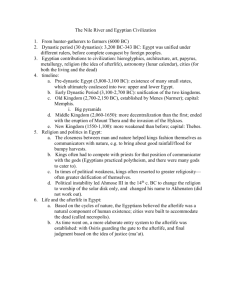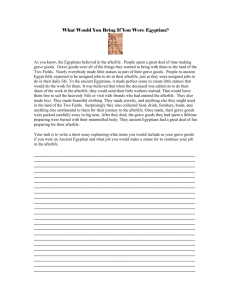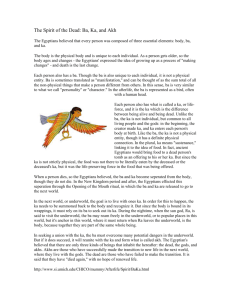The Afterlife - People Server at UNCW
advertisement
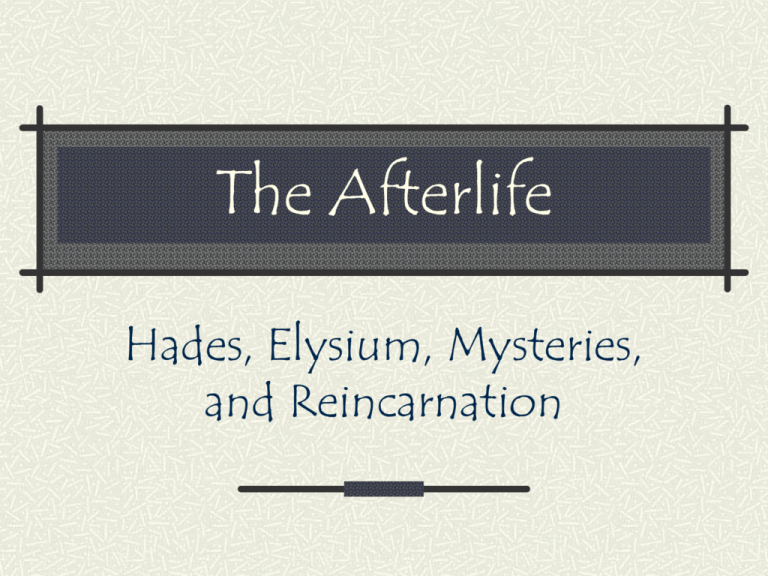
The Afterlife Hades, Elysium, Mysteries, and Reincarnation Sources: Homer Greek Epic Poet, c. 700 BCE The Iliad, focusing on warrior’s lives and experiences, gives a grim picture of the Afterlife. In the Odyssey, Odysseus journeys to (or has a vision of) the Underworld. He sacrifices a black ram and the spirits come forward to drink the blood. Only after they have drunk the blood do they recognize him. Tiresias the prophet is the only one who still has his intellect intact. All of the other spirits wander as lost souls, “strengthless ghosts” who “gather around the pit, with indescribable screaming.” Sources: Homer Odysseus sees his friend Elpenor, who has just died, and begs for burial. Burial is vital to the soul, which cannot enter the Underworld if unburied. He sees his mother, and tries to embrace her three times, but three times she flutters away like a dream or a shadow. This is no deceit of the goddess Persephone, but the fate of all who perish. No more do the sinews hold their flesh and bones in their places, but the burning heat of the pyre overwhelms and crumples our flesh. Once the soul has abandoned the body, the poor homeless spirit must flutter about like a dream, then vanish forever. Sources: Homer Finally, Odysseus sees Achilles. “No one, Achilles, of all men past or yet to be born is more blessed than you . . .” Achilles: “Don’t you attempt to instruct me on death, O learned Odysseus! Better to be a sharecropper on some poor landholder’s farm, a man who is landless and hungry himself, than here to be ruler of all these shriveled-up dead.” Sources: Homer Homer’s Underworld: •grim, depressing place, focusing attention on the value of life in the here and now •spirits are sad, lost, mere shades of their former selves. •a place where the visitor can encounter history, the great people of the past, and see them as if on display •a place of punishment for particularly nasty evildoers But does Homer’s underworld represent the average Greek’s idea of the afterlife, or is it partly a literary creation, or a one-sided view of the possibile fates of the soul? Sources: Plato Greek Philosopher, c. 370 BCE Like his views of Eros, Plato’s views on the fate of the soul are not in alignment with the mainstream of Greek literary myth. •Er dies in battle but returns to life to tell his tale: a near-death experience. •Souls are sent either into heaven or below the earth to be punished or rewarded x10 for their deeds on earth. •Souls pick the lot in life they want: some make good choices, some bad. •They drink the water of Lethe and are sent back to earth. Let one who has drawn the first lot choose a life. Virtue is without a master . . . The blame belongs to the one who makes the choice; the god is blameless. Sources: Plato Socrates: We shall believe that the soul is immortal and able to endure every extreme of good and evil. Thus shall we always hold to the upward path and always pursue justice with wisdom, so we may be friends to ourselves and to the gods both during our time here and afterward, like victors in the games who go to collect their prizes. Socrates Sources: Vergil Roman poet, BCE/CE Virgil wrote his Aeneid in the years before his death in 19 BCE. In this poem he treats the origins of the Roman Empire in mythological form. An underlying theme is the sorrow and compromise a good man must make in order to live in a changed, difficult world – like the one the Romans now found themselves in. The underworld scene in his Aeneid echoes Homer, but has its own focus: A glorious future, built on the tragedies and losses of the past. Sources: Vergil Aeneas wants to meet his father in the afterlife. To find out how, he journeys to Cumae and consults the Sibyl. With the golden bough in his hand, he goes into the cave that leads to the underworld. Notable encounters: There are twin gates of Sleep; one is of horn, through which easy exit is given to the true shades. The other is wrought in shining ivory, but through it the spirits send false dreams up into the sky . . . Aeneas left by the gate of ivory. •spirits of suicides and murder victims, still lost in their sorrows; •mythic criminals in Tartarus •souls ready to be launched into the world for future generations of Romans. Elements of the Afterlife: Styx Souls must cross the river Styx to get into the Underworld. It is the river the gods swear by when they make and oath. It was actually a real river in central Greece. As at Cumae, real and mythic landscapes mixed. Another underworld river was the Acheron. Lethe was the fountain of forgetfulness. “Great crowds of the dead swarmed out and rushed on down to the water, to the slimy banks of the Styx in an endless torrent of humans, a crowd like swirling leaves that fall from the branches in autumn . . . Just so the dead came stretching their hands in longing to cross to the opposite shore.” Vergil Elements of the Afterlife: Charon Charon, the ferryman, transports the newly dead across the river Styx. Bodies were buried with an obol (small coin) in their mouths, to pay the ferryman’s fee. “Charon, whose flaming red eyes peered over a greasy grey beard . . . loads the dead to the gunwales of his rusty, leaky old hull.” Vergil Elements of the Afterlife: Cerberus Cerberus was the threeheaded dog that guarded the underworld. The dead would throw him a honeycake as they entered; he would let them pass. Everyone else – keep out! Cerberus was descended from Poseidon and Medusa. Elements of the Afterlife: Hades & Persephone Hades is also known as Pluto (“the enricher”) or by the Romans, as Dis (“Wealthy”). Why? Persphone rules at his side. Other judges of the Underworld are sometimes shown, such as Minos or Rhadymanthos. Coming up before an authority figure seems to be a common afterworld image. Elements of the Afterlife: Tartarus Tartarus, the deepest level of Hades, was reserved for mythically outrageous evildoers, not ordinary “sinners.” Among them: The Titans, thrown there by Zeus. Tityus, who tried to rape Leto, now having his liver eternally eaten out. Elements of the Afterlife: Tartarus Sisyphus, who told on Zeus for an affair, and then tricked Death. Now he is condemned to roll a rock uphill forever: And clouds of dust rose around his head as he strained . . . Elements of the Afterlife: Tartarus Tantalus, who fed his own son to the gods in a stew. Tantalus I saw, who was suffering terrible torments. He stood in a swampy lake, whose water reached up to his chin. Strain as he might in his thirst, he could never drink the water, which soaked down into the mud at his feet. From the trees that arched above his head drooped the richest, ripest fruit: but whenever he tried to reach them, a gust of wind blew them away to the shadowing clouds. Homer, Odyssey Elements of the Afterlife: Tartarus And Ixion, who tried to rape Hera, now bound foerver to a flaming wheel. Elements of the Afterlife: The Elysian Fields AKA Elysium, the Elysian Fields are paradise: but not for ordinary people, but for the great heroes of myth. Elements of the Afterlife: The Elysian Fields It is not your fate, Menelaus, friend of the gods, to meet man’s usual fate. No, the immortals will send you off to the field of Elysium, to the very ends of the earth. Snow never falls, nor destructive storms or violent cloudbursts, for the ocean constantly sends fresh breezes to brace and refresh the sprits. Elements of the Afterlife: The Soul The soul was associated with the breath – the invisible, intangible natural element that animates the living body (Powell). When the breath is gone, the body is dead, but where is the breath? Elements of the Afterlife: Burial Burial is necessary for the dead to cross over into the Afterlife. However unpleasant the afterlife is, being tied to this earth by unfinished business is worse. Bodies could be buried or cremated. Offerings were commonly left on important occasions by female members of the family. Elements of the Afterlife: Burial Even when the deceased is thought of as gone on to the next life, artistic representations show closeness at the tomb. Here the deceased stands by his tomb while a female relative leaves offerings on the other side. Democritus: Atomic Soul •The soul is made of atoms, spherical and light, like fire •When you die, the absence of breath triggers the release of the soul, which return to the universe as atoms finis
